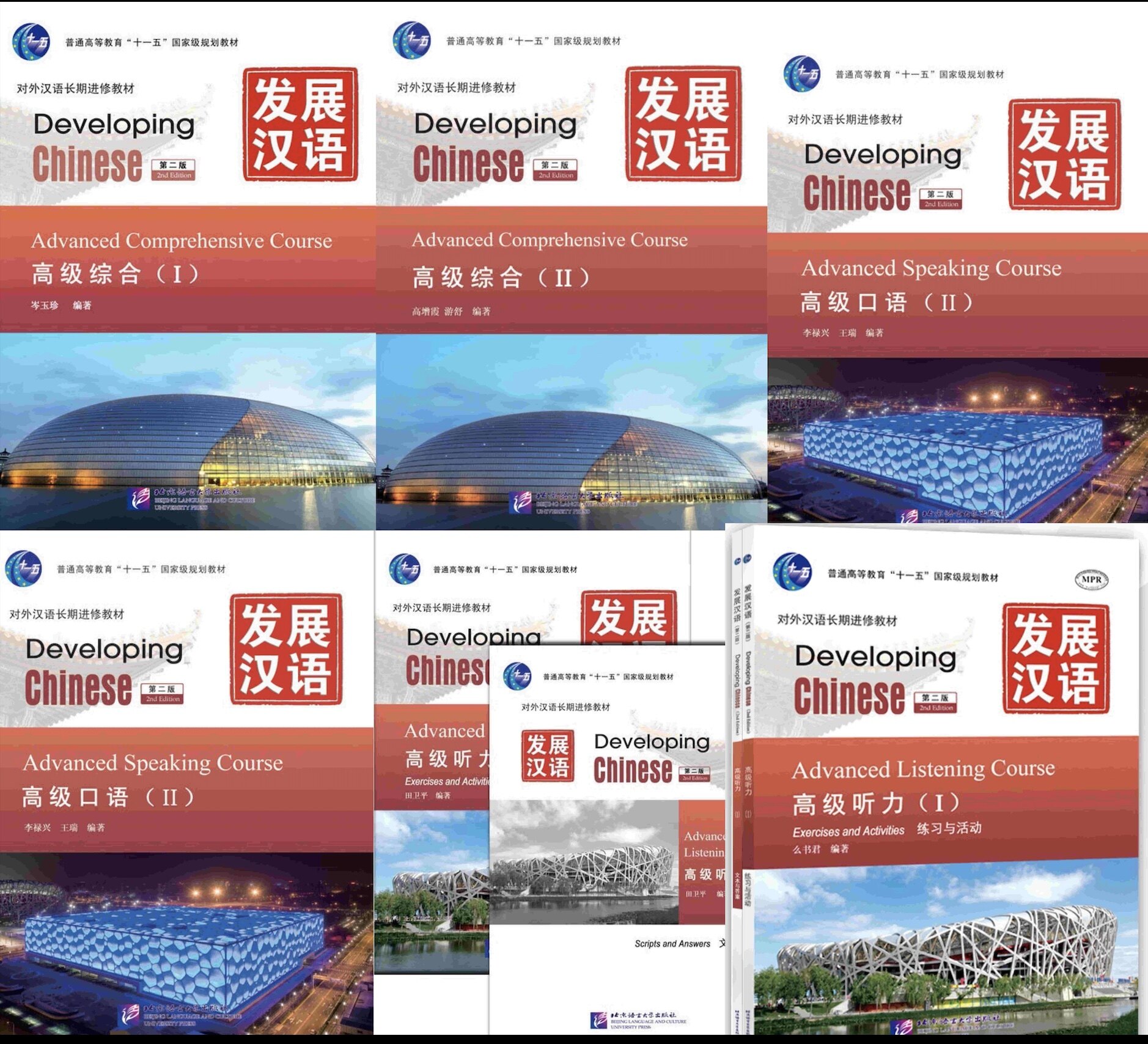پس از انتخاب نوع چاپ با کلیک بر روی کلمه "اضافه به سبد خرید" کتاب های خود را به راحتی خرید نمایید

کتاب چینی Developing Chinese Advanced Writing 2
خرید کتاب چینی Developing Chinese Advanced Writing 2
نویسنده : Rong Ji Hua
ناشر : BLCU Press
شابک : 9787561932698
سال چاپ : 2020
نوع جلد : شومیز رحلی
تعداد صفحات : 134
زبان کتاب : چینی انگلیسی
تعداد جلد : 1

جزئیات
مشاوره استفاده
در مجموع 12 درس، 2 تا 4 ساعت کلاس / درس
در حال توسعه چینی (ویرایش دوم)، مجموعه ای از کتاب های درسی آموزش عالی برای برنامه پنج ساله ملی یازدهم با مجموع 28 جلد (یا 34 کتاب)، تلاش برای کمال بر اساس چارچوب نسخه اصلی خود و همگام با زمانه .
این مجموعه از مواد آموزشی از حالتی پیروی می کند که در آموزش زبان های خارجی و تدوین کتاب های درسی استفاده می شود، یعنی «ادغام توسعه توانایی های زبانی جامع در آموزش مهارت های زبانی خاص». این به "سه سطح و پنج سری" تقسیم می شود، یعنی به صورت عمودی به سطوح ابتدایی، متوسط و پیشرفته و به صورت افقی به مجموعه های جامع، شنیداری، گفتاری، خواندن و نوشتن تقسیم می شود. از این میان سریال جامع به صورت عمده و بقیه سریال های حمایتی هستند. هدف کلی توسعه و بهبود مهارت های زبان چینی دانش آموزان، مهارت های ارتباطی چینی، قابلیت های یکپارچه چینی و همچنین افزایش علاقه و توانایی آنها در یادگیری زبان چینی است.
دوره نویسندگی پیشرفته (II) که بعد از دوره پیشرفته نوشتن (I) دنبال می شود، برای زبان آموزانی مناسب است که به ساختار گرامر اصلی چینی تسلط دارند، تقریباً 3500 کلمه چینی و کسانی که با سبک رایج زبان نوشتاری آشنا هستند. در مجموع دارای 12 درس است که هر درس در 2 تا 4 ساعت کلاس تدریس می شود. این کتاب با تمرکز بر موضوعات داغ مرتبط با دانشجویان جامعه معاصر توسعه یافته است. از طریق بحث و بررسی ترکیبات مدل، به دانش آموزان می آموزد که به تدریج بر نکات کلیدی این درس تسلط پیدا کنند و مهارت های نوشتاری آنها را بهبود می بخشد. در عین حال، با تمرکز بر موضوعات، مراحلی مانند "خواندن و تمرین" و "تمرین های توصیه شده" برای دانش آموزان طراحی شده است تا تمرین بیشتری انجام دهند و تمرین نوشتاری خود را تقویت کنند. ترکیبهای مدل جالب، کاربردی و قابل تقلید آسان هستند، تمرینها گام به گام طراحی میشوند و به نکات کلیدی در نوشتن پایبند هستند و تکالیف به درستی تنظیم میشوند. با استفاده از این کتاب درسی، دانش آموزان بیشتر و بیشتر به نوشتن به زبان چینی علاقه دارند. هر روش تدریس به وضوح مشخص شده است، بنابراین برای معلمان بسیار راحت است.
Details
Usage Advice
12 lessons in total, 2~4 class hours/lesson
Developing Chinese (2nd Edition), a set of Higher Education Textbooks for the National 11th Five-Year Plan with a total of 28 volumes (or 34 books), endeavors for perfection based on the framework of its original edition and keeps pace with the times.
This set of teaching materials follows the mode used in foreign language teaching and textbook compilation, i.e., “integrating the development of comprehensive language abilities into the training of specific language skills”. It is divided into “three levels and five series”, i.e., vertically divided into elementary, intermediate and advanced levels and horizontally divided into comprehensive, listening, speaking, reading and writing series. Among them, the comprehensive series is the bulk and the others are the supportive series. The overall purpose is to develop and improve students’ Chinese language skills, Chinese communication skills, integrated Chinese capabilities as well as enhance their interest and ability in learning Chinese.
The Advanced Writing Course (II), following the Advanced Writing Course (I), is suitable for learners who have mastered the basic Chinese grammar structure, approximately 3500 Chinese words and those who are familiar with the common style of written language. It has altogether 12 lessons, each of which is taught in 2~4 class hours. The book is developed focusing on the hot issues closely related to students of the contemporary society. Through discussing and studying the model compositions, it teaches students to gradually master the key points in this lesson and improves their writing skills. At the same time, centering on the topics, steps like “Reading and practicing” and “Recommended exercises” are designed for students to make further practice and reinforce their writing practice. The model compositions are interesting, practical and easy to be imitated, with the exercises being step-by-step designed sticking to the key points in writing and the assignments being properly-arranged. Upon using this textbook, students will like writing in Chinese more and more. Each teaching procedure is clearly marked, thus making it highly convenient for teachers.
About the Author(s)
Cen Yuzhen, the Associate Professor of the School of Teaching Chinese as a Foreign Language, Renmin University of China, graduated from Chinese Department of Beijing Normal University in 1983 and had engaged in Teaching Chinese as a Foreign Language since 1987. She took on one of the research projects of Hanban--the research and compilation of the dictionary of practical Chinese adverbs; and participated in another research project of Hanban, the compilation of Pedagogical Chinese Grammar Taught to Foreigners. She has written textbooks such as Developing Chinese—Advanced Chinese (I), Developing Chinese—Advanced Writing Course (I) and Developing Chinese —Advanced Writing Course (II) and published papers such as the Investigation and Analysis of the Meanings and Usages of轻易on Language Teaching and Linguistic Studies.
Table of Contents
电影与影评
范文讨论与学习:谈谈电影《一个都不能少》
边读边练:电影《音乐之声》的成功因素分析
写作知识要点:电影评论的写法
语言表达的概括性
艺术与歌曲
范文讨论与学习:谈谈歌曲《月亮代表我的心》
边读边练:吴冠中和他的《小鸟天堂》
写作知识要点:如何提出议论文的观点
如何把道理分析表述清楚
职业理想与道德
范文讨论与学习:英国记者卡特的新闻照片
边读边练:律师拒绝为犯罪嫌疑人辩护是违反职业道德的
写作知识要点:论据(1):运用理论论据证明议论文的观点①
运用“即使
老师与学生
范文讨论与学习:宽容之心和教育艺术
边读边练
写作知识要点:如何对议论文的题目进行加工
表示顺序的词语的运用
经济发展与环保
范文讨论与学习:对一个“环保事件”的看法
边读边练:为了一棵老树
写作知识要点:如何在不同的看法中表达自己要选择的观点
多项定语的表达作用
成功与失败
范文讨论与学习:失败是好事还是坏事
边读边练:取得成功的因素
写作知识要点:论据(2):以事实为论据证明议论文的观点
条件句在议论文中的表达作用
友谊与幸福
范文讨论与学习:谈谈友谊在生活中的地位
边读边练:什么人是幸福的
写作知识要点:论据(3):运用理论论据证明议论文的观点②
直接引用和间接引用
自信与谦虚
范文讨论与学习:自信是事业成功的条件
边读边练:谦虚是美德
写作知识要点:议论文开头的几种方法
对比方法以及例证、引证等方法的综合运用
“而”、“相反”等转折连词的对比作用
电视与阅读
范文讨论与学习:电视是不是“谋害”阅读兴趣的凶手
边读边练:良药利病不苦口
写作知识要点:驳论文的写法
“然而”与“无论”在议论文中的运用
文学与读书笔记
范文讨论与学习:读《红楼梦》笔记
边读边练:读中国明代小说《西游记》笔记
写作知识要点:写读书笔记的作用
写读书笔记的几种方法
毕业论文写作训练(一)
范文讨论与学习:从《端午的鸭蛋》看汪曾祺的语言艺术
边读边练:2010年中国网络新词特点分析
写作知识要点:毕业论文的性质与基本要求
如何选择毕业论文题目
毕业论文写作训练(二)
范文讨论与学习:失学青少年犯罪情况分析
边读边练:韩国留学生使用“是”字判断句的偏误分析
写作知识要点:毕业论文的基本格式
毕业论文正文的结构
调查数据的意义



